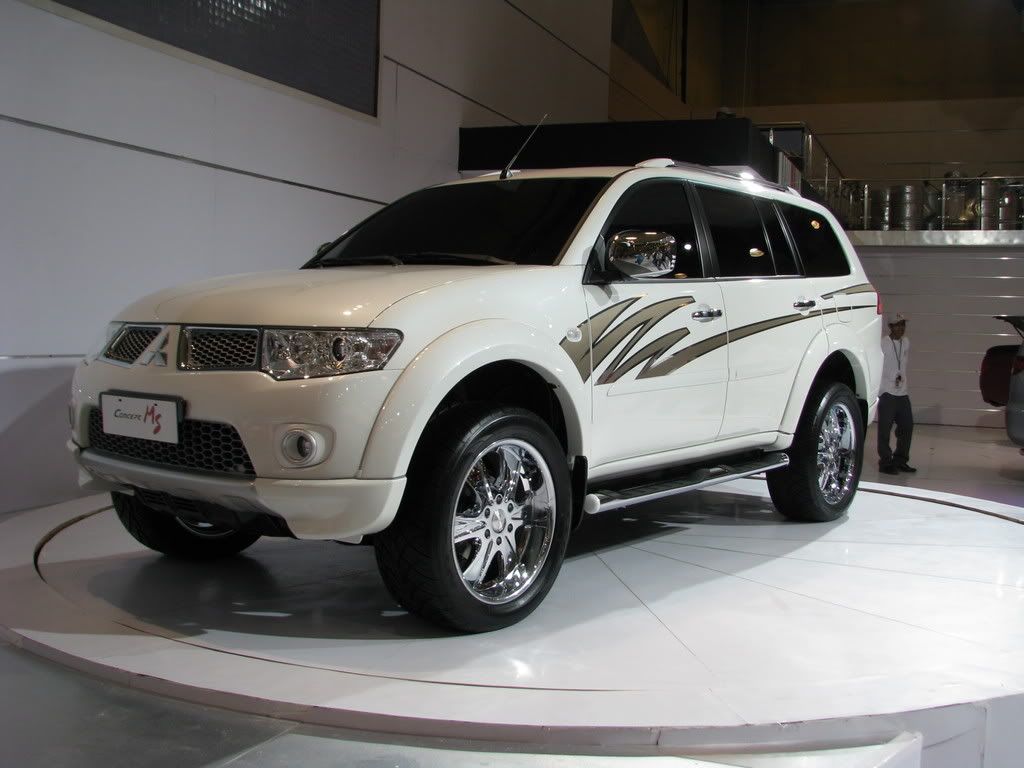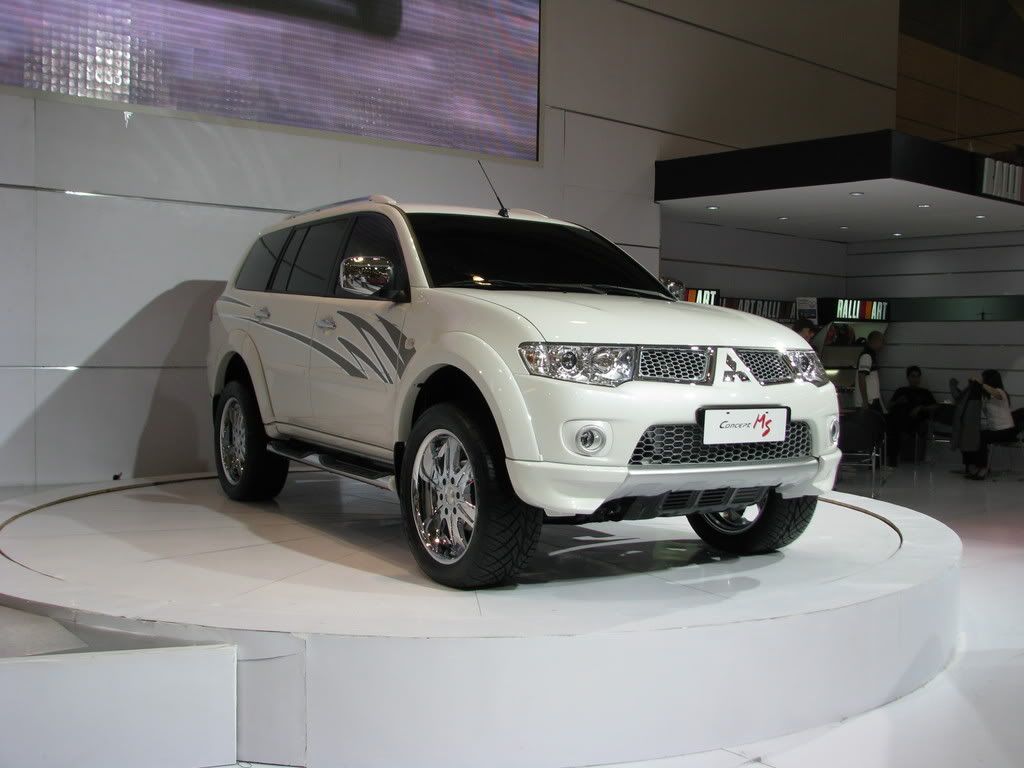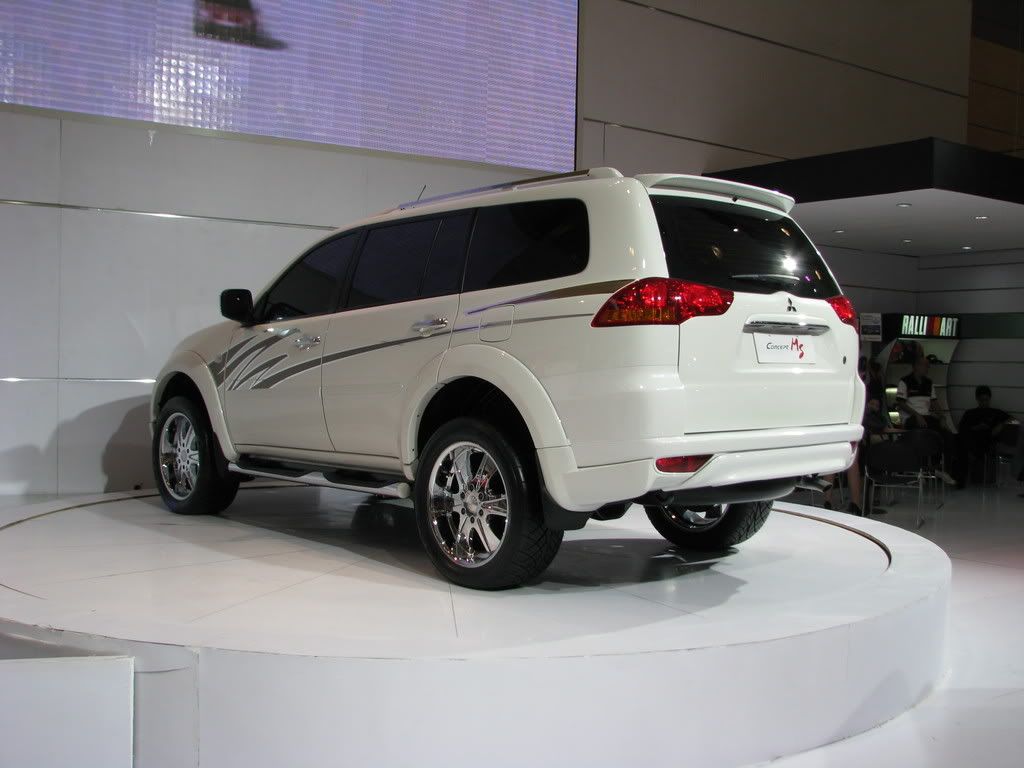Results 141 to 150 of 9388
-
August 24th, 2008 07:55 PM #141
argh... too much chrome. need glasses
Damn, son! Where'd you find this?

-
 Tsikoteer
Tsikoteer

- Join Date
- Apr 2008
- Posts
- 6,235
August 25th, 2008 01:04 AM #142Talagang maganda ang harap esp. pag gagawin nilang honeycomb grille yung buo, pero parang nasobrahan sa haba tapos sobrang mataba ang likod. Sana naman ang taillights ginawa nilang LED type at prominent dapat ang rear bumper at pwede rin isali ang malaking tow hook ng Fieldmaster para makalabas ang tough truck look. sa tingin ko ok naman ang features pero magiging sweet talaga pag sinali nila ang Rockford Fosgate HU ng Outlander
 . I'm very anxious to see the full specs of this car as well as a full review from the country.
. I'm very anxious to see the full specs of this car as well as a full review from the country.
-
 Verified Tsikot Member
Verified Tsikot Member

- Join Date
- Feb 2008
- Posts
- 117
-
-
-
 Tsikot Member
Tsikot Member

- Join Date
- Jan 2008
- Posts
- 2
August 27th, 2008 11:50 AM #146Maganda... Very promising. Let's see if this model might get a big chunk from the market of toyota fortuner.
-
 Tsikot Member Rank 3
Tsikot Member Rank 3

- Join Date
- Feb 2004
- Posts
- 863
August 27th, 2008 12:18 PM #147Just read about it sa Inquirer. Two variants daw at 1.48M and 1.66M
I wonder what's the difference between the two
-
August 27th, 2008 05:18 PM #148
Article from Philippine Star. To answer your question, pls. see the last two paragraphs of the article below.
On track with the Mitsubishi Montero Sport
TEXT AND PHOTO By Andy Leuterio
Wednesday, August 27, 2008
Conventional wisdom says that you do not test drive a Sport Utility Vehicle on a racetrack. The latter, with its tricky curves and overall layout designed to max out a car’s performance envelope, can bring out the worst of an SUV’s handling traits. A typically high center of gravity means it will lean heavily at every turn, for example. A series of left-right-left sweepers meant for the razor sharp handling of a race car will greatly exaggerate a clumsier vehicle’s dumbed-down steering, like your typical SUVs. So, when Mitsubishi Motors Corporation Philippines sent a bunch of us motoring press to Thailand to test drive their all-new Montero Sport at the Bira race circuit – a go-kart track that’s actually even trickier than a proper race track for cars – eyebrows raised in unison. They must be pretty confident then.
We arrived at the racetrack to find a small fleet of Montero Sports practically straining against their leashes. Those familiar with the previous model already know that it was a competent, but rather expensive, SUV in the same class as the Ford Everest, Toyota Fortuner and Isuzu Alterra: truck-based, ladder frame chassis SUVs with part-time 4WD systems and gutsy diesel engines. Compared to the rest, the Montero Sport had a sit-on-the-floor seat height, an undistinguished (if reliable) diesel powertrain, and overly truck-ish details from the dashboard layout to the stiff ride height. But competition improves the breed, and as the Strada has evolved into one of the most aggressive looking pickups in the market, so has this new take on the Montero Sport.
It’s a bit inaccurate to describe the new SUV as just “a Strada with a roof”, but the similarities are many. The hawk-like visage with the toothy grille and projector-type foglamps look interchangeable with the Strada’s, but the front clip is about the only part that makes it resemble the truck. Everything else is unique to the Montero Sport’s, from the gentle slope of the roofline towards the rear to the clean cut-lines of the fenders and doorsills. It does look mildly generic to the jaded buyer’s eye, which is why the Strada similarity should be a good thing. At the very least, the Montero Sport does not look wimpy. Minor, but subtle, touches that add to the masculine aura include the tubular stepboards and the bulging fenders, the type that are just crying out to be filled with extra large wheels.
Inside, Mitsubishi obviously had to cut costs somewhere, which explains the dashboard. If a Strada owner were blindfolded, put in the driver’s seat, and had the blindfold removed he’d be forgiven for thinking he was back in his Strada. The dashboard’s major elements – the IP, the center console, the glove compartment – are shared with the Strada. Fortunately, the dashboard is a very nicely styled element already, so there really doesn’t seem to be a need for a completely different look. The instrument panel is legible and faintly futuristic, while the center of the dash is graced by an LCD multi-information panel for heading, altitude, barometer, fuel consumption, range, date, and time. Just like the Strada, the Montero Sport’s cockpit makes the prospect of driving a truck seem fun and even racey.
So we did. Out of Bira’s pit lane is a sweeping left followed immediately by a right. Starting out with a 7/10ths pace to first get a feel for the Montero, the first impression is that the steering is remarkably sharp for an SUV, and a truck-based SUV at that. There’s none of the play on center typical of trucks, just a sharp responsiveness with crisp turn-in that gives you the confidence to take on a set of curves with the knowledge that the tires will point exactly in proportion to how you turn the steering wheel. After the first few curves I was aiming for the apexes as if I were in an Outlander; the Montero Sport handles much like its smaller sibling. Much of the credit for the Montero’s steering accuracy must go to its front double wishbones and rear multi-link system consisting of 3-links and long trailing arms. Braking power from the front disk-rear drum setup is strong and linear, and with a modest amount of mushiness to prevent that jerking feeling in stop-and-go traffic. Enter a curve a little too quickly to the point that you must trail brake and the Montero’s protestations are predictable: the front end plows outward, while there’s just a hint of rear end rotation for you to anticipate and correct with steering and pedal pressure. Even though we were on a kart track, the Montero Sport was responsive and predictable enough to – at the very least – not be a handful on the tight turns. On returning to pit lane, we noticed we had taken everything in stride as if we’d gone around in a car; no drama, no sense of impending doom from torturing a tall truck on a tight course.
One thing that race tracks don’t exactly flatter you with when you put production vehicles on them is the drivetrain. With long straights and an absence of traffic, it’s easy to think that you’re going slow when you are in fact already hitting the low 100s on the speedometer. The Montero Sport’s sole engine fitment (at least for now) is the 4M41 common rail direct injection diesel. Displacing 3.2-liters (same as in the biggest engine of the Strada) and benefiting from double overhead camshafts and 16 valves, rated power is 163 PS at 3,500 rpm and 35 kg-m of torque at 2,000 rpm; 30.4% more powerful and 17.4% torquier than the old Montero Sport’s 2.8-liter. Three point two liters is a lot of displacement for a 4-cylinder, so revving it is neither fun nor productive. The 4M41 sounds unapologetically industrial when you rev it past 3,000 rpm, but there’s just enough sound deadening material in the cabin to mute out the harshest frequencies so all you’ll hear is the droning of the engine. Anyway, with peak power at 3,500 rpm it’s pointless to redline the engine, so you’re better off being gentle with the accelerator and trusting the transmission to do its job. Speaking of which, the standard is a 4-speed automatic with the INVECS-II Sportronic mode. The gear ratios are spaced well apart in favor of low highway engine speeds, and the only realistic usage for the Sportronic might be going up or down a mountain road when you’ll want to hold 2nd or 3rd gear. Just as with the Pajero and Strada, the available 4WD hardware comes in the form of the “Super Select” system with shift-on-the-fly ability for High range, a mud crawling Low gear, and even a limited slip differential.
True to form, Mitsubishi throws in everything but the kitchen sink for the Montero Sport. Two variants will be offered: GLS, and GLS SE. The JVC stereo gets USB and AUX ports, Bluetooth connectivity and 6-speakers in the GLS SE variant (the GLS gets 4-speakers). There’s also an auto climate system with rear aircon control, electrically adjustable driver’s seat, power folding mirrors, convenience sockets, 2 special keys with built in electronic immobilizer, and leather seats for the SE (the GLS gets fabric seats and a manual A/C system). The de rigeur 3rd row bench is livable for kids and small nannies, but at least whoever has to sit back there will be spared the nausea thanks to the Montero Sport’s rear coil spring suspension.
The introductory price of the Montero Sport is P1.430M for the GLS and P1.598M for the GLS SE, but soon after the suggested retail prices will be P1.5M for the former and P1.680M for the latter. At those prices, it’ll be competing with its Outlander sibling, but that one is a car-based (Lancer) SUV with 5-passenger capacity and gasoline engines. The Montero Sport, on the other hand, has a 7-passenger capacity, a diesel powertrain, and a heavy duty 4WD system to compete against the likes of the Ford Everest, Isuzu Alterra, and Toyota Fortuner. With its raffish looks, “tame truck” ride, capable performance, and value-for-money features, the Montero Sport is proof yet again that the revamped Mitsubishi lineup is on a roll.
-
 Verified Tsikot Member
Verified Tsikot Member

- Join Date
- Jan 2008
- Posts
- 18
August 27th, 2008 05:21 PM #149i think mitsubishi will be at an advantage (for the buyers)) competing with the competitors with relatively lower price
 . considering they are selling the 4x4 variant of a little over 1.4M. we'll have to wait and see the performance...
. considering they are selling the 4x4 variant of a little over 1.4M. we'll have to wait and see the performance...
-
August 27th, 2008 10:17 PM #150
IMHO mas pogi ang montero in person.
share ko lang photo ng Montero.

more models here:
Motor show














![Google Play New Mitsubishi Montero Sport [ARCHIVED]](https://play.google.com/intl/en_us/badges/images/generic/en_badge_web_generic.png)
As expected, in response to Tesla’s entry into the Philippines market, Ford will be bringing in the...
Tesla Philippines